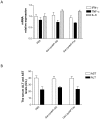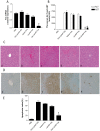A novel in vivo siRNA delivery system specifically targeting liver cells for protection of ConA-induced fulminant hepatitis
- PMID: 22970170
- PMCID: PMC3435394
- DOI: 10.1371/journal.pone.0044138
A novel in vivo siRNA delivery system specifically targeting liver cells for protection of ConA-induced fulminant hepatitis
Abstract
Background: Fulminant hepatitis progresses to acute liver failure (ALF) when the extent of hepatocyte death exceeds the liver's regenerative capacity. Although small interfering RNA (siRNA) appears promising in animal models of hepatitis, the approach is limited by drawbacks associated with systemic administration of siRNA. The aim of this study is to develop a hepatocyte-specific delivery system of siRNA for treatment of fulminant hepatitis.
Methodology/principal findings: Galactose-conjugated liposome nano-particles (Gal-LipoNP) bearing siRNA was prepared, and the particle size and zeta potential of Gal-LipoNP/siRNA complexes were measured. The distribution, cytotoxicity and gene silence efficiency were studied in vivo in a concanavalin A (ConA)-induced hepatitis model. C57BL/6 mice were treated with Gal-LipoNP Fas siRNA by i.v. injection 72 h before ConA challenge, and hepatocyte injury was evaluated using serum alanine transferase (ALT) and aspartate transaminase (AST) levels, as well as liver histopathology and TUNEL-positive hepatocytes. The galactose-ligated liposomes were capable of encapsulating >96% siRNA and exhibited a higher stability than naked siRNA in plasma. Hepatocyte-specific targeting was confirmed by in vivo delivery experiment, in which the majority of Gal-LipoNP-siRNA evaded nuclease digestion and accumulated in the liver as soon as 6 h after administration. In vivo gene silencing was significant in the liver after treatment of Gal-Lipo-siRNA. In the ConA-induced hepatitis model, serum levels of ALT and AST were significantly reduced in mice treated with Gal-lipoNP-siRNA as compared with control mice. Additionally, tissue histopathology and apoptosis showed an overall reduction of injury in the Gal-LipoNP siRNA-treated mice.
Conclusions/significance: This study is the first to our knowledge to demonstrate reduction of hepatic injury by liver-specific induction of RNA interference using Gal-LipoNP Fas siRNA, highlighting a novel RNAi-based therapeutic potential in many liver diseases.
Conflict of interest statement
Figures





Similar articles
-
Targeted gene silencing of TLR4 using liposomal nanoparticles for preventing liver ischemia reperfusion injury.Am J Transplant. 2011 Sep;11(9):1835-44. doi: 10.1111/j.1600-6143.2011.03660.x. Epub 2011 Jul 27. Am J Transplant. 2011. PMID: 21794086
-
RNA interference targeting Fas protects mice from fulminant hepatitis.Nat Med. 2003 Mar;9(3):347-51. doi: 10.1038/nm828. Epub 2003 Feb 10. Nat Med. 2003. PMID: 12579197
-
Osteopontin small interfering RNA protects mice from fulminant hepatitis.Hum Gene Ther. 2007 Dec;18(12):1205-14. doi: 10.1089/hum.2007.069. Hum Gene Ther. 2007. PMID: 17988193
-
Superparamagnetic iron oxide nanoparticles modified with polyethylenimine and galactose for siRNA targeted delivery in hepatocellular carcinoma therapy.Int J Nanomedicine. 2018 Mar 26;13:1851-1865. doi: 10.2147/IJN.S155537. eCollection 2018. Int J Nanomedicine. 2018. PMID: 29618926 Free PMC article.
-
Acute liver failure: mechanisms of hepatocyte injury and regeneration.Semin Liver Dis. 2008 May;28(2):167-74. doi: 10.1055/s-2008-1073116. Semin Liver Dis. 2008. PMID: 18452116 Review.
Cited by
-
In vivo siRNA delivery of Keap1 modulates death and survival signaling pathways and attenuates concanavalin-A-induced acute liver injury in mice.Dis Model Mech. 2014 Sep;7(9):1093-100. doi: 10.1242/dmm.015537. Epub 2014 Jul 4. Dis Model Mech. 2014. PMID: 24997191 Free PMC article.
-
Long non-coding RNAs: critical players in hepatocellular carcinoma.Int J Mol Sci. 2014 Nov 7;15(11):20434-48. doi: 10.3390/ijms151120434. Int J Mol Sci. 2014. PMID: 25387074 Free PMC article. Review.
-
Evaluation of RNA Secondary Stem-Loop Structures in the UTRs of Mouse Hepatitis Virus as New Therapeutic Targets.Pathogens. 2024 Jun 19;13(6):518. doi: 10.3390/pathogens13060518. Pathogens. 2024. PMID: 38921815 Free PMC article.
-
Nucleic acid-based nanotherapeutics for treating sepsis and associated organ injuries.Theranostics. 2024 Jul 16;14(11):4411-4437. doi: 10.7150/thno.98487. eCollection 2024. Theranostics. 2024. PMID: 39113804 Free PMC article. Review.
-
Galactose protects hepatocytes against TNF-α-induced apoptosis by promoting activation of the NF-κB signaling pathway in acute liver failure.Lab Invest. 2015 May;95(5):504-14. doi: 10.1038/labinvest.2015.34. Epub 2015 Mar 9. Lab Invest. 2015. PMID: 25751739
References
-
- Vaquero J, Blei AT (2003) Etiology and management of fulminant hepatic failure. Curr Gastroenterol Rep 5: 39–47. - PubMed
-
- Sass DA, Shakil AO (2005) Fulminant hepatic failure. Liver Transpl 11: 594–605. - PubMed
-
- Kawakami S, Hashida M (2007) Targeted delivery systems of small interfering RNA by systemic administration. Drug Metab Pharmacokinet 22: 142–151. - PubMed
-
- Akhtar S, Benter I (2007) Toxicogenomics of non-viral drug delivery systems for RNAi: potential impact on siRNA-mediated gene silencing activity and specificity. Adv Drug Deliv Rev 59: 164–182. - PubMed
Publication types
MeSH terms
Substances
Grants and funding
LinkOut - more resources
Full Text Sources
Research Materials
Miscellaneous

